The Yeti 160E is a fun mountain bike. Really fun. There’s nothing dull about a ride with 170mm front and 160mm rear travel. Tack on those 29-inch wheels plus the new Shimano EP8 drive unit with 85Nm of torque and you’ve got yourself a bonafide pedal-assist party.
You may be asking yourself, “what took Yeti so long to release an e-bike?” Well, Yeti’s answer is “It Took Time To Make Time.” This phrase means virtually nothing to me, but let’s just go with it. It took some time to design an e-bike built specifically for enduro racing, and which would also appease us normal folk, their consumers.
Frame details
Yeti chose to use their TURQ series carbon, which is one reason for the high price tag. It reduces the overall weight and adds the stiffness and responsiveness you’d expect from any Yeti. All cables are internally routed and run along a tray between the battery and frame. Modular cable ports securely clamp shifter housing and brake lines, keeping everything securely in place. Additionally, cable ports can be plugged if the rider chooses to run a wireless setup. Chain slap is virtually non-existent, managed with a chainstay protector and a OneUp chain guide, complete with a hole for the derailleur housing to run through. Another unique feature is the shock drain hole, located below the lower shock mount.
Be sure to read our in for test article about the Yeti 160E for full specs and additional photos.

True to Yeti fashion, they’ve also designed a thermoplastic handlebar that integrates the Shimano E-Tube wire that runs between the remote switch and the display unit. The unit, mounted on the handlebar, displays battery life, mode, and speed. It’s a nice feature to have if you like to constantly view numbers, or if you’re actually racing this bike. However, I don’t care about numbers, or how fast I’m going, and I don’t need to constantly observe battery life. I found the display distracting and would prefer to have it integrated into the top tube to be observed purposefully and not accidentally.
Sizes M-XL accommodate a full-size water bottle cage. Unfortunately, the small frame only has room for a hot lap bottle. Bummer.
The 64.5° head tube angle is perfect for aggressive riding, and the 78° seat angle works great for pedaling even without motor assistance. The 430mm reach was ideal for a small enduro bike, keeping me nicely situated. When pedaling uphill in Trail or Boost mode I moved my body forward more than I would on an analog bike because as the motor engages with a pedal stroke, the bike jolts forward and if you’re not hanging on, your body will move backward. The 446mm chainstays are a perfect length to make handling this 50lb behemoth easy-ish. The E160 is quite heavy, providing a solid upper body workout downhill. However, the chainstay length combined with 29-inch wheels, allow for maximum maneuverability and a “point it downhill and go” attitude.
Trail performance
I live in Golden, Colorado, a decidedly badass place to live if you’re into mountain biking. As it happens, Yeti HQ is also located in Golden. Most of my test rides were performed on local trails where I see Yeti factory riders and employees riding lunch loops most days. The trails here are largely dusty, loose, and peppered with plenty of rocky obstacles. Colorado had an unusually hot and dry fall this year, so trail conditions were ultra-dry and loose for most of my testing which is interesting to navigate with the weight and accompanied speed of the Yeti 160E.
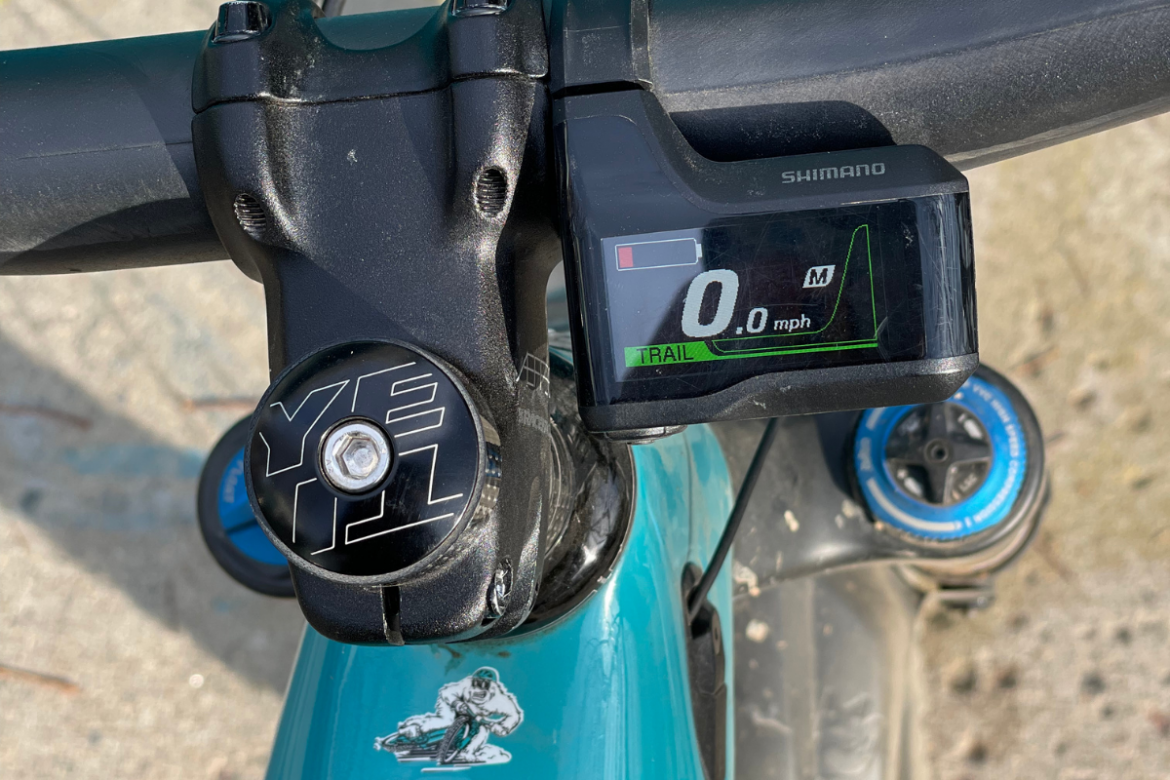
My ride distances varied between 10-34 miles and often involved weaving through several trail networks, selecting the most aggressive climbs and chunkiest descents I could find in order to hit the limit of battery life. On my longest test ride, I rode 34 miles with 6,000 feet of rocky, technical elevation gain on Trail mode (medium-power). I actually ran out of time before I could utilize the entire battery, leaving one bar of the five. I’ve seen some complaints about the battery life on the 160E, however, it seems sufficient for most people’s athletic endeavors. Had I left the bike in Eco mode or vacillated between modes, I likely could have ridden an additional 1.5 hours, which would make the distance somewhere in the 55+ mile range.
Descending
My non-motorized, medium carbon frame bike weighs an impressively heavy 33lb which by all accounts is a lot. The Yeti 160E weighs 50lb without pedals, which is just under half my body weight and heavier than some e-MTB’s in the category. This weight is most noticeable when descending and It’s something to consider if you have the impression that e-bikes magically enable or enhance bike handling skills. They don’t. Quite the contrary, excellent bike handling skills and some amount of fitness are required to ride the 160E to its full potential.
I weigh a measly 115lb and even with my stronger-than-average female upper body, 50lb of bike is difficult to maneuver down chunky terrain, especially when wet. A few test rides were completed in winter conditions, on snow-covered rocks and roots. The forward momentum and mass of the bike combined with slick surfaces made the bike sketchy AF downhill and hard to execute a controlled stop. This criticism is not reserved for Yeti specifically, but e-MTBs in general. This is also not to say the 160E doesn’t handle well. It does. In fact, I am impressed by its overall maneuverability when selecting last minute lines or quickly ducking into corners. On smooth flowy trails, the weight did not affect my rides negatively. On the contrary, it made the bike feel more planted and allowed me to rail through flow and corners with confidence.

Adding 50lb to my body weight made it possible to go much faster than normal, which was fun and terrifying. Faster speeds combined with a heavy bike require ample stopping power. The 160E is specced with SRAM Code RSC brakes and SRAM Centerline rotors; 220mm on the front and 200mm on the rear. This rotor setup is useful for slowing down a heavy bike, however, I would prefer if both rotors were 220mm. I found the need to brake earlier than normal when approaching dry, loose corners and extra stopping power with less heat and brake fade would be helpful for sustained, steep descents. That being said, I have no problems with the brakes themselves. Once correct timing is established, the 160E can stop on a dime.
Weight aside, the 160E is a bonafide shred sled. On trails littered with chunky descents, drops, rocks, and tight switchbacks the 160E feels firmly planted, traction heavy and precise. I’m impressed by how well the suspension performs overall. With less anti-rise across the travel, the suspension stays very active and consistent, compression after compression. I hit a fair amount of brake bumps during my test period and the 160E remained level, feeling almost supple. I didn’t get bucked around through the chunder as much as I initially suspected at high speeds.
When jumping I found the response time to be a bit slower than my analog bike, which is to be expected. However, once I pulled the trigger on my first jump, subsequent jumps became easier and I really enjoyed seeing what the 160E could do. Large drops are a no-brainer on the 160E. The 170/160mm of travel really does wonders for my confidence in this department. The suspension is perfect for sending it into oblivion. Landings feel pillowy plush regardless of what leverage chip is in use.
Climbing
The Yeti 160E navigates sustained, smooth climbs, like a dreamboat. Even on loose pebbles, the 160E offers an impressive amount of traction despite the additional torque. Eco mode is enough for most climbs, but a quick flip to Trail or Boost mode on a fire road and I literally felt like I was riding a dirt bike. The slightest pedal pressure propels the bike forward and I have to hang on. Luckily the 78° seat tube angle is well suited for this, making it possible to shift weight forward and keep equal pressure on the wheels.
One downside to the suspension setup is a slight loss of pedaling efficiency. The 160E does bob a bit uphill, however, this is masked by the additional power. So long as the cranks keep moving the traction is consistent, regardless of gear choice. Honestly, I feel bad passing people one-handed uphill, fiddling with my phone, casually talking to them as if they aren’t in a pain cave.
It is more difficult to navigate technical ascents with the 160E. You may think, “just turn it up to Boost and motor through,” but it actually requires a bit of finesse. There is so much torque applied in these modes, that the rear wheel loses traction on loose, dust-covered obstacles. Eco mode provides a nice amount of assist for uphill features while keeping the wheels grounded. In certain instances — natural uphill rock gardens, for instance — Trail mode can be useful for plowing through while maintaining forward momentum.
Due to the bike weight, I found it difficult to wheel lift over some features. I resolved this problem by timing a ratchet pedal stroke in combination with a lift. As previously mentioned, any amount of pedal pressure causes the motor to engage immediately with all the power the particular mode offers. Thus, when ratcheting, power is applied suddenly, with no modulation. In Trail or Boost mode, this results in a wheelie and potential loop out if your body position isn’t ready for a sudden forward thrust from the bike. I really have to think about my body position in relation to the power of the Shimano motor when ascending. A “boobs over bars” forward standing climbing position combined with motor assist, for instance, results in loss of traction in the rear wheel and is not necessary with the addition of power. I’m not saying you shouldn’t be forward while climbing, it’s similar to a normal bike, but also different. On most technical obstacles I found myself in a standing crouched climb; lowering my center of mass in order to maintain consistent traction.
While climbing with the 160E, you’re less gassed throughout a climb, which leaves ample energy to finagle the sections that require more finesse. Small obstacles are a non-issue, and it boosted my confidence to plow up some steeps that I don’t make on my regular bike. I suspect that having more upper body strength and mass would change my perspective on the bike’s climbing capabilities.
Sixfinity Suspension
The time it took Yeti to develop an e-MTB was primarily spent allowing engineers to think through the laws of physics and create a new e-exclusive suspension platform: Sixfinity. First prototyped in 2016, the new Sixfinity suspension platform consists of a six bar linkage and lower link switches, the function of which is somewhat similar to Yeti’s patented Switch Infinity Technology.
The Sixfinity linkage was designed specifically to play nice with the Shimano STEPS EP8 motor. It takes time to carefully consider and address the position, added power, weight, and unique demands of an e-bike built for racing, and to create an entirely new suspension platform that can function around a motor and still be tunable. This time suck served Yeti well, as the new suspension boasts a stiff, supportive chassis that accommodates the speed, motor, battery, and mass of the bike.

Sixfinity uses a six-bar linkage design with a lower link that switches directions as the suspension progresses through its travel. The switch link initially rotates upward, providing a wide and flat band of anti-squat for smooth and supported pedaling. As soon as the suspension reaches its inflection point, it switches directions and rotates downward until bottom-out, causing the anti-squat to drop off progressively. This allows the suspension to be active and to move more freely deeper in the travel and when pedaling isn’t a priority.
Compared to a traditional bike, e-bikes use a greater range of gears when climbing and the Sixfinity suspension allows for consistency and predictability regardless of gear choice. The Yeti 160E has a flip-chip adjustable leverage rate, which allows for a 10% change to the rate of suspension progressivity while geometry, anti-squat, and anti-rise remain consistent. The leverage rate settings can be modified by selecting one of three “discs” placed directly into the frame below the shock. The stock position is set at 30%, providing a nice balanced ride. However, the discs can be switched to 25% for a firmer, more efficient ride, or 35% for a plush feel with more pop.

In theory, the flip-chip makes a lot of sense. In practice, however, it’s a pain in the butt. Unless you have a nice bike stand and a burning desire to tinker with your bike settings before the ride, I recommend finding the chip that works well most of the time and sticking to that. I rode all three settings and prefer the stock chip for a nice balance, but I might switch to 35% for a non-stop chunk fest.
Shimano EP8 Drive System
The Shimano EP8 drive motor system is a smaller, lighter, and more powerful version of its predecessor the E8000. The EP8 settings can be accessed remotely via Shimano’s E-TUBE app, which seems useful if you’re into fine-tuning motor preferences, power output, and checking battery health.
The internal components of the EP8 motor have also been updated, resulting in a quicker cut-out time. When pressure is applied to the pedals the motor engages, and when pressure is released, it disengages, so it seems to work.
The Yeti 160E comes with Shimano’s larger 630w semi-integrated battery, removable via a 4mm Allen key, with a small charging port on the non-drive side. It’s worth noting that the charging port cover is a bit of a pain. You have to slide an extremely small and thin plastic piece precisely into a tiny slot in order to secure it. If not done properly moisture can seep in.
In addition to motor performance, the EP8 height has been shaved by 5mm for better ground clearance. This is a great feature because even with increased clearance, the 350mm bottom bracket height still had me stuck on a few rocks that aren’t a problem with analog bikes. This problem is accentuated by the weight of the bike, which isn’t as easy to bunny hop over obstacles.
One downside to the EP8, and maybe Shimano motors in general, is the sound. I don’t know if it was the volume or the pitch that bugged me, but the EP8 has a very distinct sound. It also seems that the motor jostles slightly while riding which is concerning. I’m not familiar with all e-bike motor options, but this one audibly annoyed me.
Final thoughts

Overall I love this bike. I found myself reaching to ride this over my analog bike simply because it’s fun to pedal without the added bonus of my heart exploding out of my chest. Though I mentioned the weight several times, it does fall within the range of normal for a full-sized e-bike. This point requires consideration if you’re a lighter rider such as myself. It was difficult to manage and first but became more intuitive after several rides.
Yeti did an amazing job creating a full-size e-bike that’s capable of racing, yet also enjoyable for the normal riders in the crowd. Though a bit of pedaling efficiency is lost in some scenarios, the Sixfinity platform is well suited for the size and weight of the 160E and the EP8 motor more than compensates for any loss in efficiency. The anti-squat, anti-rise properties keep the suspension active and precise throughout, providing stability, while also feeling supple and plush regardless of leverage rate selection. The EP8 motor gives ample power, performs well, and sits high enough to avoid most rocks. It does make an annoying sound; perhaps only noticeable to those of us with dog-like hearing. The battery life is sufficient for the size and I never worried I was going to run out of juice, even on the longest rides.
If you’re considering racing in the e-MTB category or are in the market to drop $12,700k, the Yeti 160E is money well spent.
- Available at Competitive Cyclist (C1 SLX model) and other online retailers
Party laps
- Excellent geometry
- Active suspension when climbing
- Stable and plush suspension when descending
- Efficient (e-bike) pedaling regardless of gear choice
- Motor delivers smooth, manageable power
- Good battery life
Pros and cons of the Yeti 160E
Dirt naps
- Price $$$$
- Weight may be difficult for some to handle down technical trails
- Technical climbing requires more finesse
- Shimano EP8 pitch and motor knocking noise
- Distracting display placement


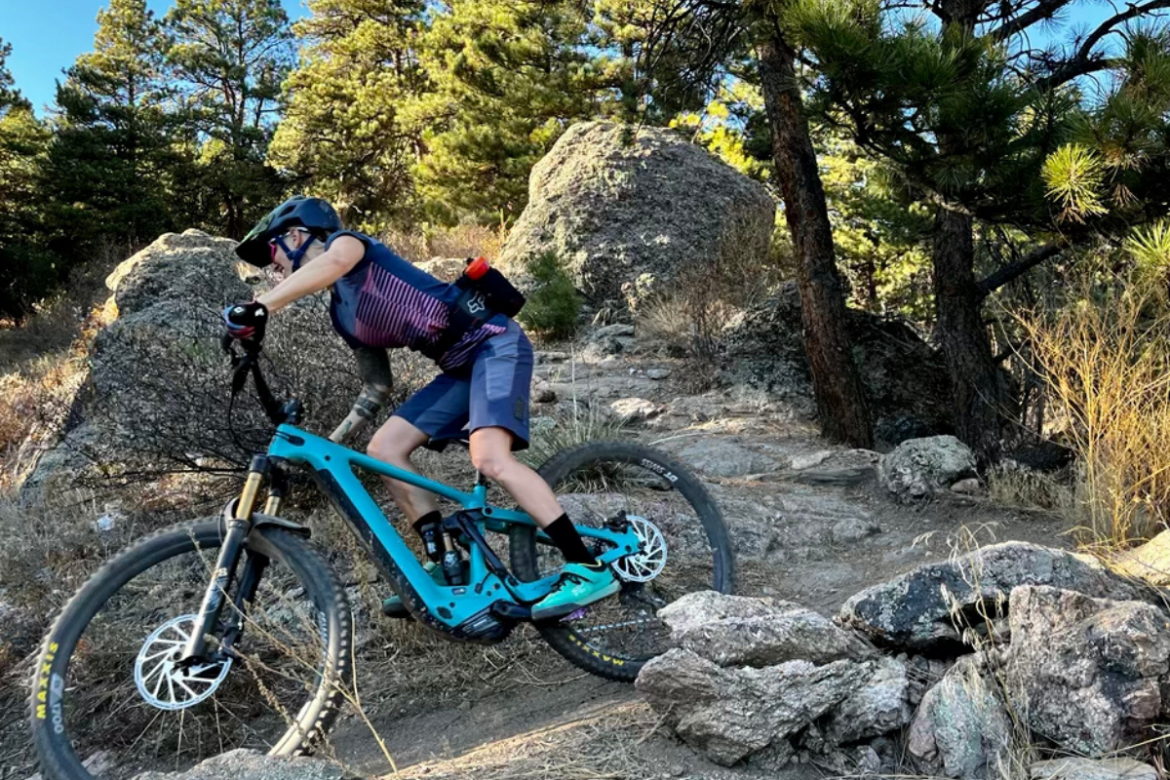

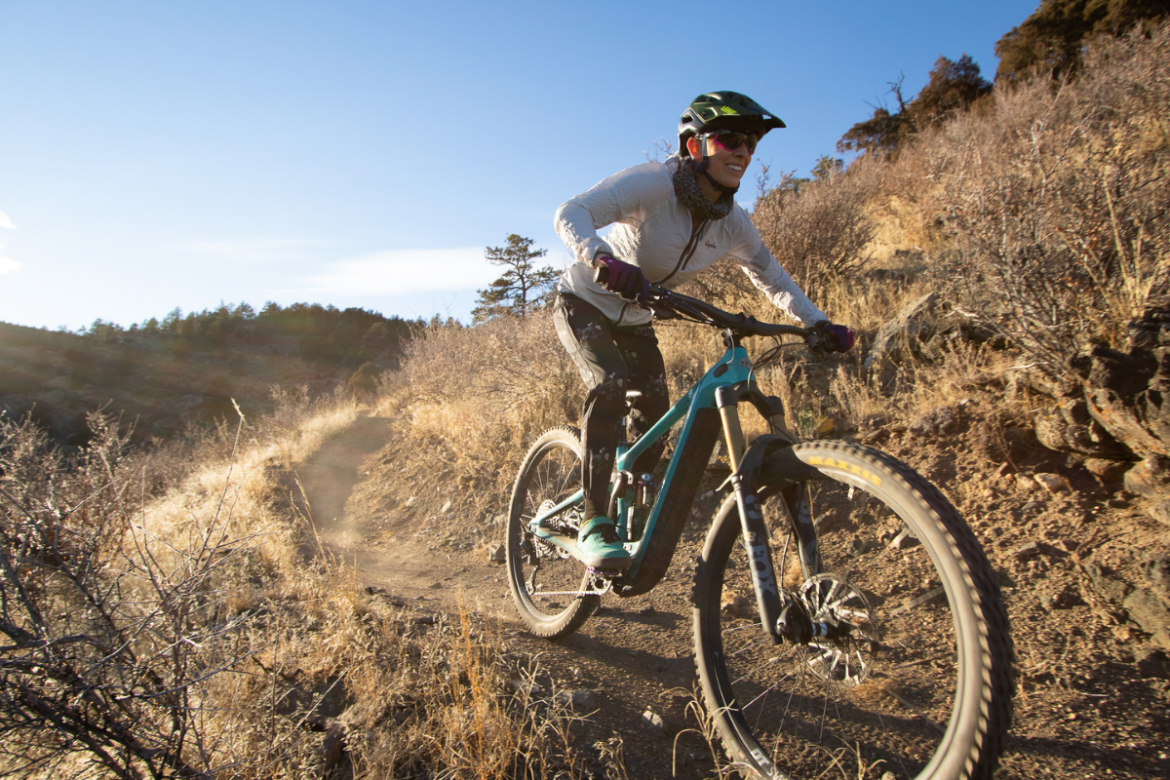

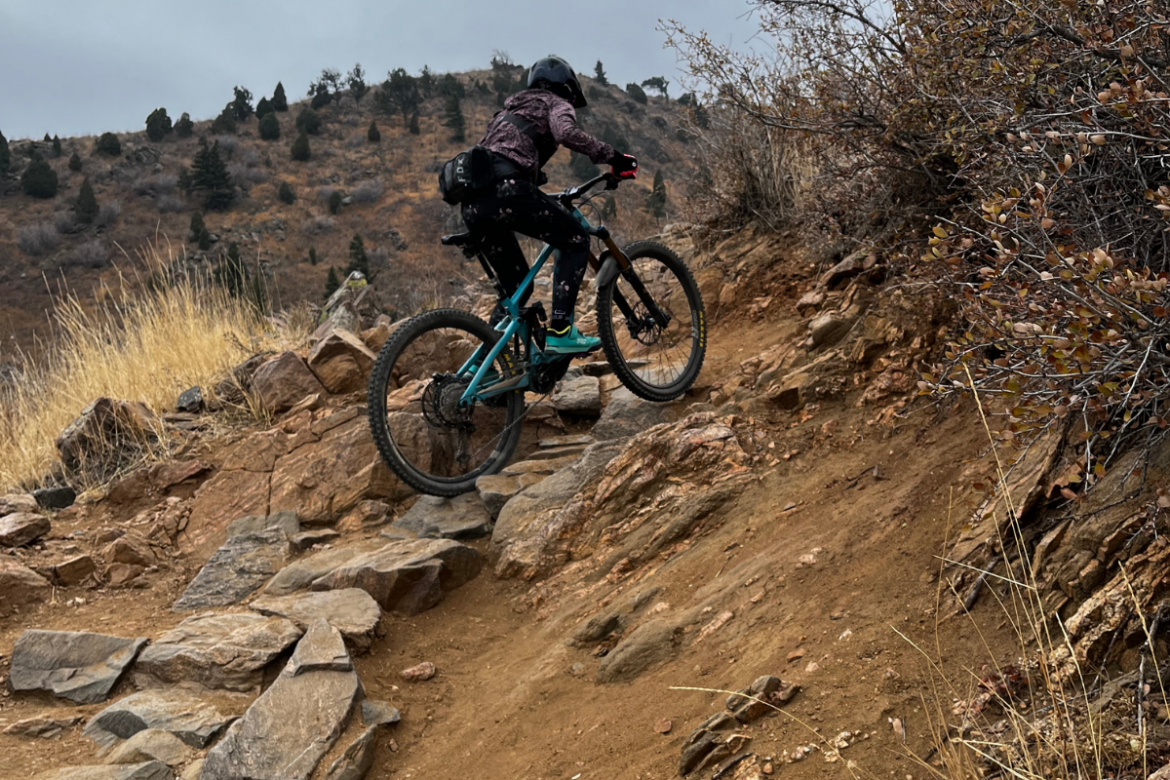
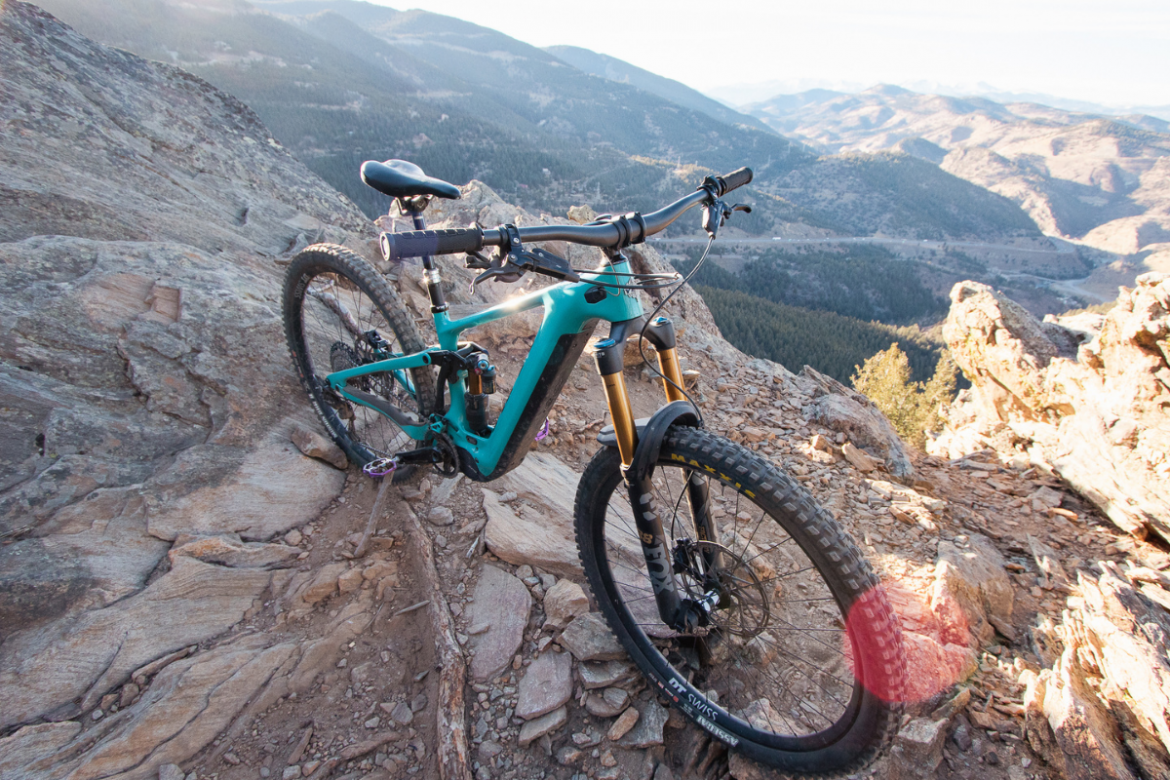





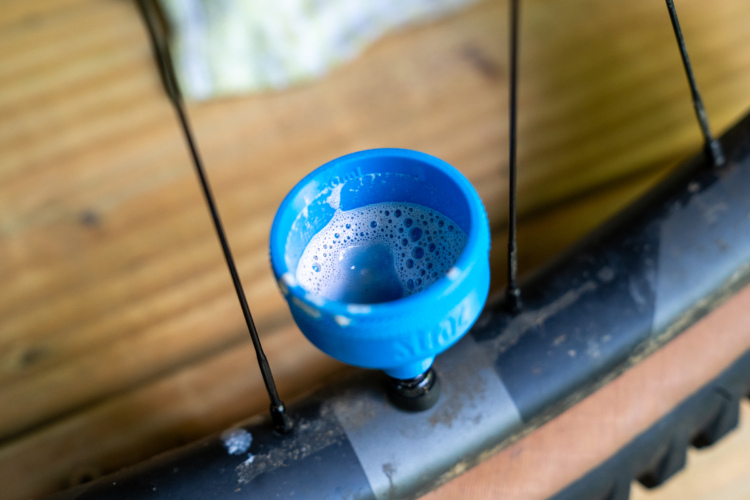


0 Comments